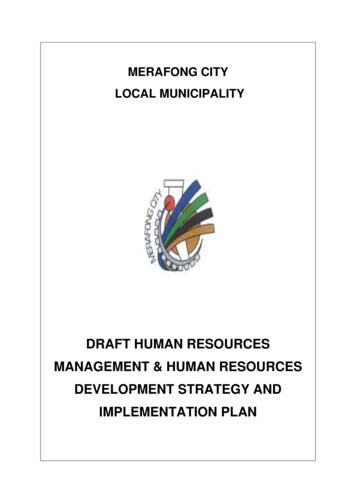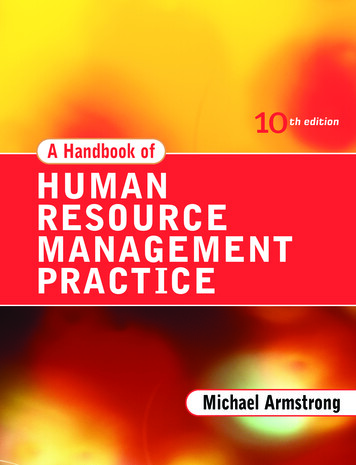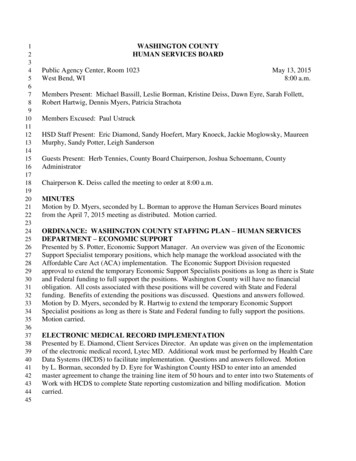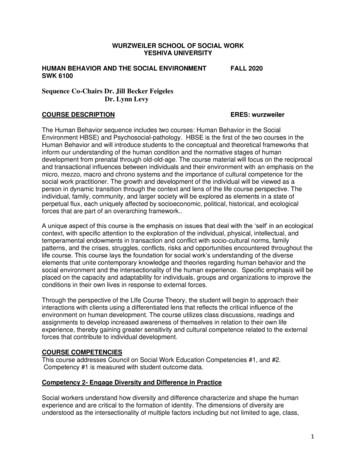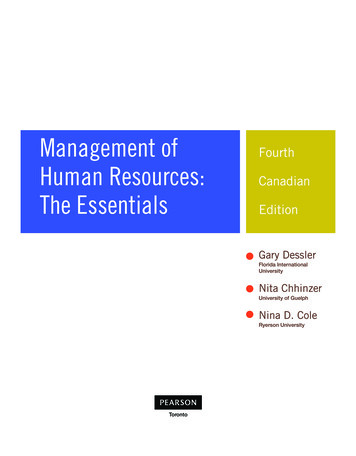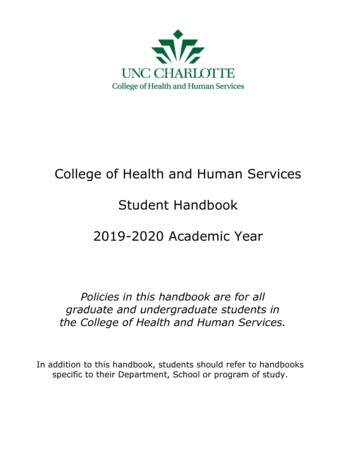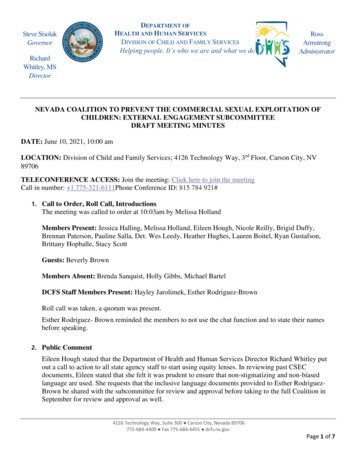
Transcription
DEPARTMENT OFHEALTH AND HUMAN SERVICESDIVISION OF CHILD AND FAMILY SERVICESHelping people. It’s who we are and what we do.Steve itley, MSDirectorNEVADA COALITION TO PREVENT THE COMMERCIAL SEXUAL EXPLOITATION OFCHILDREN: EXTERNAL ENGAGEMENT SUBCOMMITTEEDRAFT MEETING MINUTESDATE: June 10, 2021, 10:00 amLOCATION: Division of Child and Family Services; 4126 Technology Way, 3rd Floor, Carson City, NV89706TELECONFERENCE ACCESS: Join the meeting: Click here to join the meetingCall in number: 1 775-321-6111Phone Conference ID: 815 784 921#1. Call to Order, Roll Call, IntroductionsThe meeting was called to order at 10:03am by Melissa HollandMembers Present: Jessica Halling, Melissa Holland, Eileen Hough, Nicole Reilly, Brigid Duffy,Brennan Paterson, Pauline Salla, Det. Wes Leedy, Heather Hughes, Lauren Boitel, Ryan Gustafson,Brittany Hopballe, Stacy ScottGuests: Beverly BrownMembers Absent: Brenda Sanquist, Holly Gibbs, Michael BartelDCFS Staff Members Present: Hayley Jarolimek, Esther Rodriguez-BrownRoll call was taken, a quorum was present.Esther Rodriguez- Brown reminded the members to not use the chat function and to state their namesbefore speaking.2. Public CommentEileen Hough stated that the Department of Health and Human Services Director Richard Whitley putout a call to action to all state agency staff to start using equity lenses. In reviewing past CSECdocuments, Eileen stated that she felt it was prudent to ensure that non-stigmatizing and non-biasedlanguage are used. She requests that the inclusive language documents provided to Esther RodriguezBrown be shared with the subcommittee for review and approval before taking to the full Coalition inSeptember for review and approval as well.4126 Technology Way, Suite 300 Carson City, Nevada 89706775-684-4400 Fax 775-684-4455 dcfs.nv.govPage 1 of 7
Esther Rodriguez-Brown added the inclusive language documents to all the subcommittee Google Docs.and they will also be sent out to all the members by Lorena Bojorquez.No further discussion on this item.3. For Possible Action: Approval of the May 10, 2021 minutes.Eileen Hough stated that her comments on the Department of Education during the last meeting wereincorrect. She would like guidance on what can be done to correct that as she plans to provide accurateinformation today.Jennifer Spencer stated that the minutes from May 10th will remain as is if they accurately reflect whatwas said and any corrections can be made today.Motion: Nicole Reilly motioned to approve the May 10th minutes; motion was seconded by BrennanPaterson. No objections, no abstentions, motion carried unanimously.No further discussion on this item.4. For Possible Action: Screening Tool PresentationsBeverly Brown presented a PowerPoint on the Nevada Rapid Indicator Tool (NRIT). She stated that theNRIT is recommended as the standardized screening tool to identify CSEC children or those at highrisk. She added that the NRIT is to be used by a trained service provider and that it does not rely on selfdisclosure, it includes indicators that could prompt confirmation followed by initiation of an MDT.Beverly read the areas for consideration when implementing the NRIT: Criteria for determining which children an NRIT should be completed on and how often.o Consider age, events or warning signs that would trigger NRITStaff requirements related to administrative- administering the tool.o What training will be provided, who is responsible to complete the tool, timeframe.Response to youth identified as High Risko How to safety plan to address risk factors, have timeframe for re-administering, how andwhen additional screening and assessment will occur, services to link the youth to.Response to youth identified as a confirmed victimo How to safety plan to address risk factors, when will MDT be initiated, will CSECmentor advocate be assigned, referral for comprehensive assessment, services to linkyouth to.Data-tracking and reporting requirements related to NRITo Where will hard copies be stored if not in electronic form, policies for confidentiality ofdata, what data is entered into agency’s information management system, what data isshared with partner agencies and Nevada SAC.Beverly then read the scenarios in which, per CSEC Policy, an NRIT would be administered: During the initial assessment phase of an investigation for every child that is 10 and older.When a child has returned from a run-away episode.Anytime in the life of the case where there are concerns that child, regardless of age, may be aCSEC victim or is at risk of being a CSEC victim.Lastly, Beverly read the highlights from policy for NRIT: Case carrying child welfare staff must take CSEC training annually.4126 Technology Way, Suite 300 Carson City, Nevada 89706775-684-4400 Fax 775-684-4455 dcfs.nv.govPage 2 of 7
Response when child is confirmed CSEC victim:o Make report to law enforcemento Initiate coordinated response MDT (6 hours if urgent, 72 hours if non-urgent, atscheduled intervals and when circumstances change)Policy includes information from CSEC Protocol, such as:o Assessing CSEC safetyo Planning for CSEC safetyo Preventing and responding to peer recruitmento Placement considerationso Preventing runawayso Assessing ongoing concerns and underlying issueso Identifying strengths and resourceso Individualized service planningBeverly added that they’re also currently working on updating the information management system to beable to enter NRIT and other data points. NRIT’s are currently completed in paper form and savedelectronically.Hayley Jarolimek stated that the NRIT was developed as a result of the work done by the last coalitionand it was designed specifically for child welfare. It would be ideal if juvenile justice in the counties andyouth parole use the NRIT to provide a unified measurement.Pauline Salla asked if other agencies use the NRIT.Heather Hughes stated that Washoe County Human Services agency uses it at Juvenile Justice indetention screenings.Pauline Salla stated that she will present the NRIT to NAJJA (Nevada Association of Juvenile JusticeAdministrators) to add as an agenda item for their next meeting; she also extended an invite tosubcommittee members to attend. She added that she is also part of the oversight commission and willadd to their subcommittee agenda as well.Melissa Holland asked if the NRIT is only used on minors.Esther Rodriguez-Brown stated that it is intended for minors however others could have moreinformation.Jessica Halling asked if data can be shared with law enforcement for funding if the NRIT isimplemented statewide.Brigid Duffy stated she is unsure if Clark DJJS and The Harbors use the NRIT. As for the data piece,she will check with Eboni Washington at Clark County on how a report can be pulled out of TylerSupervision for the use of it as an assessment.Esther Rodriguez-Brown reminded the members that the Funding, Data and SustainabilitySubcommittee is working toward establishing a central database that could house statewide CSEC data.Stacy Scott stated that the NRIT is used in the ARYS unit at Clark County. They’re currently workingon including the NRIT in UNITY for minors 10 and older; it will be a requirement before any caseclosure. Hard copies are currently scanned into UNITY but the data points aren’t easily accessed.4126 Technology Way, Suite 300 Carson City, Nevada 89706775-684-4400 Fax 775-684-4455 dcfs.nv.govPage 3 of 7
Beverly Brown stated that the NRIT will be tied to each specific child, reports should include allrequired data points including demographics. Currently they are in the final stages of the workgroup,which includes waiting to meet with UNITY for development after finalization.Eileen Hough asked if the NRIT is billable via Medicaid as it may potentially be an incentive foragencies to use it. If it is not billable, it would be beneficial to determine whom in the Division ofHealthcare Financing and Policy would be the person to contact to see if it the NRIT can be billed.Jessica Halling stated she has never heard of the NRIT being billable to Medicaid.Melissa Holland asked if victim advocates with law enforcement agencies use the NRIT.Hayley Jarolimek stated that there may be restrictions with NRIT billing due to the individualsadministering it seeing that it is not a clinical tool.Eileen Hough volunteered to compile some background information on requirements for billing viaMedicaid.No further discussion on NRIT presentation.Heather Hughes stated she met with Dr. Amy Guevara from DCFS; she is the statewide implementationlead and a certified CANS trainer. The CANS is used throughout all DCFS programs and with Washoespecialized foster care youth. The CANS is administered at intake and every 90 days, it is trackedthrough Avatar software. Heather shared that the goal for statewide use is to have one CANS completedthat can be accessed throughout so that different types of providers aren’t duplicating the efforts. TheCANS requires training/certification, which is currently only available online and although the cost isminimal, Dr. Guevara has vouchers available to those interested in training free of charge. Heatherproceeded to present the different completion areas of the CANS form as it was displayed for those inattendance.Esther Rodriguez-Brown asked if only trained therapists use the CANS and if the training includestrauma bonding/trauma informed aspects. She added that if this is used in a multidisciplinary teamenvironment, they need to tread with caution so as to not re-traumatize.Heather Hughes stated that the CANS is not only used by trained therapists which is why it would beideal to have it completed as a team during an MDT.Jessica Halling stated that the CANS is mandatory in specialized foster care, it is very time consumingand cannot be billed because CSAII, which is also required, is billed. CANS is also done every 90 daysand can take hours to complete. She added that she will follow up with the St. Jude’s Ranch for Childrenclinical team to confirm billing details. Currently, completed CANS forms are scanned to DCFShowever there is no knowledge as to how or if the data is stored once received. She added that they’reworking with their internal data collection system to transition into a system where CANS is built-in,and data can be pulled.Hayley Jarolimek stated that Systems of Care unit under DCFS is responsible for CANS underChildren’s Mental Health therefore she will follow up to see what the barriers are on implementationand billing.No further discussion on CANS presentation.Holly Gibbs was not in attendance therefore the PEARR tool presentation is tabled until the nextmeeting.4126 Technology Way, Suite 300 Carson City, Nevada 89706775-684-4400 Fax 775-684-4455 dcfs.nv.govPage 4 of 7
Motion: Jessica Halling motioned to have the PEARR tool presented at the next meeting if Holly Gibbsis available, Nicole Reilly seconded motion. No objections, no abstentions, motion carried unanimously.Eileen Hough stated that the Department of Education expressed they are not currently in a place torecommend a screening tool; each school chooses what works best for them. As a screening tool, theCASII is not diagnostic, however Eileen endorses it as it leads to treatment planning.Jessica Halling stated she relies on CANS more than CASII and CUMHA, she will follow up with theSt. Jude’s Ranch for Children clinical director, to see how she uses CASII.Heather Hughes stated that she uses CASII for all youth in specialized foster care and all childrencoming into foster care. It is used to determine levels of care as there are three levels; Family Foster,Enhanced Homes and Specialized Foster Care. She added that the CASII provides a cumulative scoreand the CANS does not.Ryan Gustafson stated that the CASII has been broadly used, probably beyond its intent. It is requiredby Medicaid for levels of care reimbursement. He added that Washoe previously attempted to crosswalkboth the CANS and the CASII and that Dr. Megan Freeman from DCFS would have more informationon the outcome.Eileen Hough asked if there is any follow-up needed on the CASII or if the discussed tools can bebrought to the June 15th coalition meeting for voting.Jessica Halling suggested waiting for the PEARR presentation so that all the tools can be compared. Sheadded that the NRIT seems to be a quick easy to use tool whereas the CANS and CASII are more indepth which should probably be completed by a mental health professional. CANS or CASII couldfollow up after an NRIT is done first. The NRIT seems to be a good initial identifier and would be agood addition to the school district.Hayley Jarolimek suggested discussion and action based on the decision even if it is decided that moretime is needed and an update can be provided at the coalition meeting on June 15th.Jessica Halling suggested finalizing the decision at the next meeting as there is still another toolpresentation pending.Eileen Hough asked if the NRIT can be brought to the coalition as there seems to be consensus on itsbenefits as an initial identifier.Nicole Reilly stated that because Objective 2b is about establishing an assessment tool for allcommunity organizations that serve CSCE and it has been found that different tools meet different needsregarding clinical vs. non-clinical, it might be best to identify one for each area.Esther Rodriguez-Brown stated that the assessment tool matrix in the Google Doc. for thissubcommittee includes nationwide tools that are community based and can be used to narrow down thechoices. She added that she could aid in reviewing the tools and present her choice for each.Jessica Halling stated that the NRIT is good for community use across the broad because it serves theneed to identify quickly. The next level of tools will need to be chosen with careful consideration basedon the child or youth’s needs but as a starting point, she suggests pushing the NRIT forward.Esther Rodriguez-Brown reminded the members that the coalition meets quarterly therefore if the NRITis a solid choice for a first step in assessment, it would be worth updating the coalition with. It could be4126 Technology Way, Suite 300 Carson City, Nevada 89706775-684-4400 Fax 775-684-4455 dcfs.nv.govPage 5 of 7
implemented as an identifying tool instead of actual assessment. This could lead to implementing it andbetween now and September, the group could work on the assessment piece.Pauline Salla asked for clarification on the NRIT being brought to the coalition, asking if bringing it tothe coalition would restrict the other tools used in other organizations.Esther Rodriguez-Brown stated that bringing the NRIT to the coalition would not mean that DJJS isobligated to start using it. She added that any of Pauline’s interested colleagues can attend the upcomingcoalition meeting.Hayley Jarolimek stated that the previous coalition included statewide Juvenile Justice representation;she can pull the names and send to Pauline Salla.Motion: Pauline Salla motioned to bring the NRIT to the Coalition, Eileen Hough seconded motion. Noobjections, no abstentions. Motion carried unanimously.No further discussion on this item.5. For Discussion and Possible Action: Work Session for Objective 2b from External EngagementSubcommittee CharterNo discussion on this item as it was covered in item 4.6. For Discussion and Possible Action: Review of External Engagement Subcommittee CharterEsther Rodriguez- Brown suggested removing the roster from the charter so that membership revisionscould take place without adhering to a voting requirement. As for the deadlines, removing them wouldadd flexibility; the timeliness would remain, they’ll just be removed from the roster so that revisions cantake place without the need for voting.Motion: Jessica Halling motioned to remove the timelines and roster from External EngagementCharter, Brigid Duffy seconded motion. No objections, no abstentions, motion carried unanimously.7. For Discussion and Possible Action: Future Agenda ItemsEsther asked the members to review the matrix in the Google Doc. and email her with which they’d liketo see presented at the next meeting.Eileen Hough asked that the inclusive language discussion be added to the August agenda, she willmake the reminder at the July meeting and the documents will be sent to the members before then.Melissa Holland summarized the future agenda items: Assessment Tool presentations Objective 2c workgroup- identifying resources for Nevada211 WebsiteNo further discussion on this item.8. For Possible Action: Confirm Next Meeting: July 8. 2021. 10:00am-11:30am (or until adjourned)Melissa Holland stated the next meeting will be on July 8, 2021 from 10:00am-11:30am.9. For Information Only: Final Public CommentNone10. AdjournmentThe meeting adjourned at 11:37am.4126 Technology Way, Suite 300 Carson City, Nevada 89706775-684-4400 Fax 775-684-4455 dcfs.nv.govPage 6 of 7
4126 Technology Way, Suite 300 Carson City, Nevada 89706775-684-4400 Fax 775-684-4455 dcfs.nv.govPage 7 of 7
4126 Technology Way, Suite 300 Carson City, Nevada 89706 775-684-4400 Fax 775-684-4455 dcfs.nv.gov . Page . of . 7

